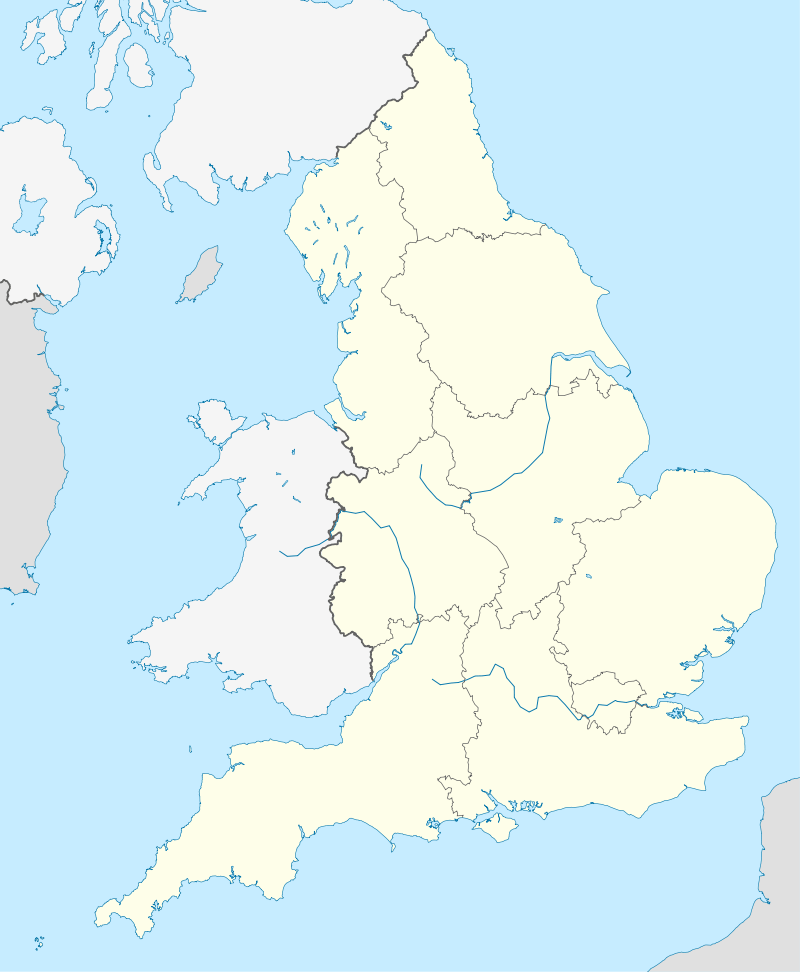List of hoards in Great Britain
The list of hoards in Britain comprises significant archaeological hoards of coins, jewellery, precious and scrap metal objects and other valuable items discovered in Great Britain (England, Scotland and Wales) and the Isle of Man. It includes both hoards that were buried with the intention of retrieval at a later date (personal hoards, founder's hoards, merchant's hoards, and hoards of loot), and also hoards of votive offerings which were not intended to be recovered at a later date, but excludes grave goods and single items found in isolation. The list is subdivided into sections according to archaeological and historical periods.
Neolithic hoards
Hoards dating to Neolithic period, approximately 4000 to 2000 BC, comprise stone weapons and tools such as axeheads and arrowheads. Such hoards are very rare, and only a few are known from Britain.
| Hoard | Image | Date | Place of discovery | Year of discovery | Current Location | Contents |
|---|---|---|---|---|---|---|
| Ayton East Field Hoard | 30th to 25th century BC | East Ayton North Yorkshire 54°15′18″N 0°28′26″W / 54.255°N 0.474°W |
1848 | British Museum, London | 3 flint axes 1 flint adze 5 arrowheads 1 polished flint knife 2 flint flakes 1 antler macehead 2 boar-tusk blades[1] | |
| York Hoard | 30th century BC | York North Yorkshire 53°57′29″N 1°04′48″W / 53.958°N 1.080°W |
1868 | Yorkshire Museum | ~70 flint tools and weapons[2] | |
Bronze Age hoards
A large number of hoards associated with the British Bronze Age, approximately 2700 BC to 8th century BC, have been found in Great Britain. Most of these hoards comprise bronze tools and weapons such as axeheads, chisels, spearheads and knives, and in many cases may be founder's hoards buried with the intention of recovery at a later date for use in casting new bronze items. A smaller number of hoards include gold torcs and other items of jewellery. As coinage was not in use during the Bronze Age in Great Britain, there are no hoards of coins from this period.
Iron Age hoards
A large number of hoards associated with the British Iron Age, approximately 8th century BC to the 1st century AD, have been found in Britain. Most of the hoards comprise silver or gold Celtic coins known as staters, usually numbered in the tens or hundreds of coins, although the Hallaton Treasure contained over 5,000 silver and gold coins. In addition to hoards of coins, a number of hoards of gold torcs and other items of jewellery have been found, including the Snettisham Hoard and the Stirling Hoard.
Romano-British hoards
Hoards associated with the period of Romano-British culture when part of Great Britain was under the control of the Roman Empire, from AD 43 until about 410, as well as the subsequent Sub-Roman period up to the establishment of Anglo-Saxon kingdoms are the most numerous type of hoard found in Great Britain, and Roman coin hoards are particularly well represented, with over 1,200 known examples. In addition to hoards composed largely or entirely of coins, a smaller number of hoards, such as the Mildenhall Treasure and the Hoxne Hoard, include items of silver or gold tableware such as dishes, bowls, jugs and spoons, or items of silver or gold jewellery.
Anglo-Saxon hoards
Hoards associated with the Anglo-Saxon culture, from the 6th century to 1066, are relatively uncommon. Those that have been found include both hoards of coins and hoards of jewellery and metalwork such as sword hilts and crosses. The Staffordshire Hoard is the largest Anglo-Saxon hoard to have been found, comprising over 1,500 items of gold and silver. More Anglo-Saxon artefacts have been found in the context of grave burials than hoards in England. These include major finds from Sutton Hoo in Suffolk, Taplow in Buckinghamshire, Prittlewell, Mucking and Broomfield in Essex, and Crundale and Sarre in Kent.
| Hoard | Image | Date | Place of discovery | Year of discovery | Current Location | Contents |
|---|---|---|---|---|---|---|
| Appledore Hoard | mid 11th century | Appledore Kent 51°01′52″N 0°47′24″E / 51.031°N 0.790°E |
1997 | British Museum, London | 490 pennies (1997) 12 silver pennies of Edward the Confessor (1998)[3] | |
| Bamburgh Hoard | mid 9th century | Bamburgh Northumberland 55°36′14″N 1°43′19″W / 55.604°N 1.722°W |
1999 and 2004 | Museum of Antiquities, Newcastle | 384 base metal stycas copper alloy fragments bronze folding balance[4][5] | |
| Brantham Hoard | 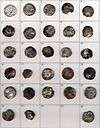 |
10th century | Brantham Suffolk 51°58′08″N 1°03′47″E / 51.969°N 1.063°E |
2003 | Fitzwilliam Museum, Cambridge | 90 silver pennies[6] |
| Canterbury-St Martin's hoard |  |
late 6th or early 7th century | Canterbury Kent 51°16′41″N 1°05′38″E / 51.278°N 1.094°E |
1840s | World Museum, Liverpool | 8 items, including 3 gold coins, and two pieces of jewellery[7] |
| Crondall Hoard | mid 7th century | Crondall Hampshire 51°13′48″N 0°51′43″W / 51.230°N 0.862°W |
1828 | Ashmolean Museum, Oxford | 100 small gold coins and 2 cloisonné pins[8] | |
| Harkirke (or Harkirk) Hoard | early 10th century | Crosby Merseyside 53°30′07″N 3°01′12″W / 53.502°N 3.020°W |
1611 | unknown[note 1] | ~300 Viking and Kufic coins[9] | |
| Ipswich Hoard (1863) | 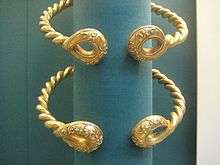 |
10th century | Ipswich Suffolk 52°03′32″N 1°09′22″E / 52.059°N 1.156°E |
1863 | 150 coins (75 now known)[10] | |
| Lenborough Hoard | mid 11th century | Lenborough, near Padbury Buckinghamshire 51°58′37″N 0°58′52″W / 51.977°N 0.981°W |
2014 | 5,251½ coins in a lead bucket, including coins of Ethelred the Unready and Canute[11] | ||
| Pentney Treasure | 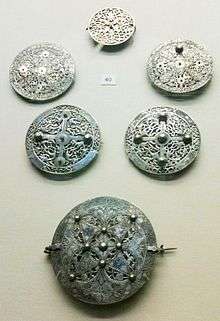 |
early 9th century | Pentney Norfolk 52°41′42″N 0°32′42″E / 52.695°N 0.545°E |
1978 | British Museum, London | 6 silver disc brooches[12] |
| Staffordshire Hoard |  |
7th or 8th century | Hammerwich Staffordshire 52°39′18″N 1°54′25″W / 52.655°N 1.907°W |
2009 | Birmingham Museum & Art Gallery Potteries Museum & Art Gallery, Stoke-on-Trent |
more than 1,500 items (about 5 kg (11 lb) of gold and 1.3 kg (2.9 lb) of silver), mostly sword fittings and decorative parts of weaponry, but also two gold crosses and an inscribed gold strip[13] |
| Trewhiddle Hoard | 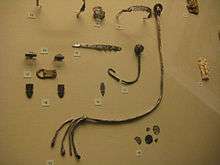 |
late 9th century | Trewhiddle Cornwall 50°19′44″N 4°48′14″W / 50.329°N 4.804°W |
1774 | British Museum, London | 114 Anglo-Saxon coins, and various items of silverware, including a scourge, a chalice and a Celtic penannular brooch[14] |
| West Yorkshire Hoard |  |
11th century | Leeds West Yorkshire 53°48′N 1°33′W / 53.8°N 1.55°W |
2008–2009 | 5 items of 7th to 11th century gold jewellery (a cabochon ring, a filigree ring, a niello finger ring, a filigree and granular ring, and a piece of a cloisonné bracelet), an ingot of gold, and a lead spindle whorl.[15] | |
Pictish hoards
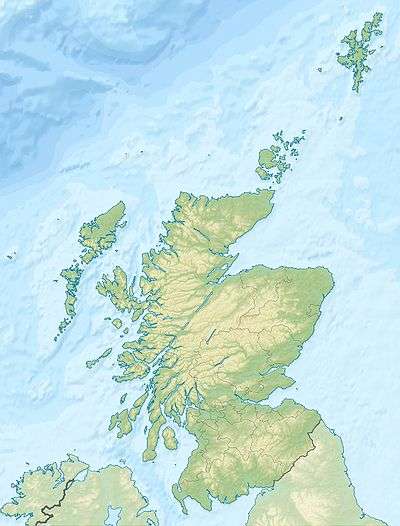
Hoards associated with Pictish culture, dating from the end of Roman occupation in the 5th century until about the 10th century, have been found in eastern and northern Scotland. These hoards often contain silver brooches and other items of jewellery.
| Hoard | Image | Date | Place of discovery | Year of discovery | Current Location | Contents |
|---|---|---|---|---|---|---|
| Aberdeenshire hoard | 4th to 6th century | Undisclosed location Aberdeenshire |
2014 | 100 pieces of hacksilver, comprising late Roman coins and pieces of Roman and Pictish silver vessels, bracelets and brooches.[16] | ||
| Broch of Burgar Hoard | late 8th century | Broch of Burgar, near Evie Orkney 59°07′52″N 3°08′02″W / 59.131°N 3.134°W |
1840 | unknown | 8 silver vessels several silver combs 5 or 6 silver hair pins 2 or 3 silver brooches several fragments of silver chains a large number of amber beads[17] | |
| Gaulcross Hoard | 6th or early 7th century | Gaulcross, near Fordyce Aberdeenshire 57°39′47″N 2°46′44″W / 57.663°N 2.779°W |
late 1830s | Museum of Scotland, Edinburgh | several silver hand pins (only one extant) 1 silver bracelet 1 silver chain several silver brooches (all lost)[18] | |
| Norrie's Law hoard | 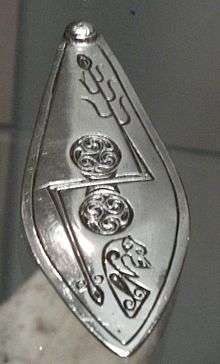 |
late 7th century | Norrie's Law, Largo Fife 56°15′18″N 2°57′11″W / 56.255°N 2.953°W |
1819 | Museum of Scotland, Edinburgh | nearly 12.5 kg of silver objects, of which all but 750 g were melted down. The 153 surviving objects include: 2 penannular brooches 2 oval plaques 3 or 4 hand-pins 2 spiral finger-rings 1 small vessel lid fragment of a 4th-century Roman spoon knife-handle mounts fragments of arm-bands various rod and chain fragments[19] |
| St Ninian's Isle Treasure | 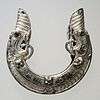 |
late 8th or early 9th century | St Ninian's Isle Shetland 59°58′16″N 1°20′31″W / 59.971°N 1.342°W |
1958 | Museum of Scotland, Edinburgh | 8 silver bowls 12 silver penannular brooches 2 silver chapes (part of scabbard that protects the point) 1 silver communion spoon 1 silver knife 1 silver pommel 3 silver cones[20] |
Viking hoards
Hoards associated with the Viking culture in Great Britain, dating from the 9th to 11th centuries, are mostly found in northern England, Orkney and the Isle of Man, and frequently comprise a mixture of silver coins, silver jewellery and hacksilver that has been taken in loot, some coins originating from as far away as the Middle East.
| Hoard | Image | Date | Place of discovery | Year of discovery | Current Location | Contents |
|---|---|---|---|---|---|---|
| Ainsbrook Hoard[note 2] | late 10th century | Thirsk North Yorkshire 54°13′59″N 1°20′35″W / 54.233°N 1.343°W |
2003 | British Museum, London | ~130 objects of gold, silver (including 10 Anglo-Saxon coins), copper alloy, lead, iron, and stone[21][22] | |
| Ballaquayle Hoard |  |
late 10th century | Ballaquayle, Douglas Isle of Man 54°08′53″N 4°28′30″W / 54.148°N 4.475°W |
1894 | Manx Museum, Douglas British Museum, London |
1 silver neck ring 1 gold arm ring 13 silver armlets 1 silver finger ring 2 silver thistle-headed brooch pins 78 Anglo-Saxon silver coins[23] |
| Bedale Hoard | 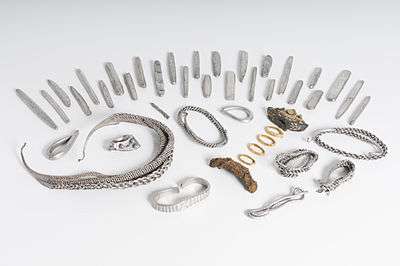 |
early 10th century | Bedale North Yorkshire 54°17′N 1°35′W / 54.29°N 1.59°W |
2012 | Yorkshire Museum, York | 1 iron sword pommel with gold foil plaques, 4 gold hoops a sword hilt, 6 small gold rivets, 4 silver collars and neck-rings, 1 silver arm-ring, 1 fragment of a silver Permian ring, 1 silver penannular brooch, and 29 silver ingots.[24] |
| Bossall-Flaxton Hoard | early 10th century | between Bossall and Flaxton North Yorkshire 54°03′00″N 0°56′42″W / 54.050°N 0.945°W |
1807 | coins, bullion, arm-ring in a leaden box[25] | ||
| Bryn Maelgwyn Hoard | early 11th century | near Deganwy Castle, Llandudno Conwy 53°18′18″N 3°48′54″W / 53.305°N 3.815°W |
1979 | National Museum Cardiff | 204 silver pennies of Cnut the Great[26] | |
| Cuerdale Hoard | 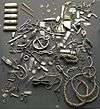 |
early 10th century | Cuerdale, near Preston Lancashire 53°45′18″N 2°38′24″W / 53.755°N 2.640°W |
1840 | British Museum, London, Ashmolean Museum, Oxford | 8,600 items including silver coins and bullion[27] |
| Dumfriesshire Hoard | mid-9th to 10th century | Dumfriesshire | 2014 | Museum of Scotland, Edinburgh | over 100 gold and silver items including armbands, a Christian cross, brooches, ingots and an exceptionally large Carolingian pot[28] | |
| Furness Hoard | 10th century | Furness Cumbria 54°12′N 3°09′W / 54.20°N 3.15°W |
2011 | Dock Museum, Barrow-in-Furness | 92 silver coins, including two Arabic dirhams, several silver ingots, and one silver bracelet.[29] | |
| Glenfaba Hoard | early 11th century | Glenfaba Isle of Man 54°12′47″N 4°39′36″W / 54.213°N 4.660°W |
2003 | Manx Museum, Douglas | 464 coins, 25 ingots and a broken armlet[30] | |
| Goldsborough Hoard | early 10th century | Goldsborough North Yorkshire 54°00′00″N 1°24′54″W / 54.000°N 1.415°W |
1859 | British Museum, London | fragments of Viking brooches and arm-rings, together with thirty-nine coins[31] | |
| Huxley Hoard | late 9th to 10th century | Huxley, Cheshire Cheshire 53°08′49″N 2°43′59″W / 53.147°N 2.733°W |
2004 | World Museum, Liverpool | 22 silver pieces (including 20 flattened bracelets)[32] | |
| Penrith Hoard |  |
early 10th century | Newbiggin Moor, near Penrith Cumbria 54°39′00″N 2°34′41″W / 54.650°N 2.578°W |
1785–1989 | British Museum, London | a number of silver penannular brooches[33] |
| Silverdale Hoard | 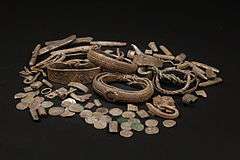 |
early 10th century | Silverdale Lancashire 54°10′N 2°50′W / 54.17°N 2.83°W |
2011 | Museum of Lancashire, Preston, Lancaster City Museum | 201 silver objects inside a box made from a sheet of lead; comprising 27 coins (Anglo-Saxon, Anglo-Viking, Frankish and Islamic), 10 arm rings, 2 finger rings, 14 ingots, 6 brooch fragments, 1 wire braid, and 141 pieces of hacksilver.[34] |
| Skaill Hoard | mid 10th century | Bay of Skaill Orkney 59°03′00″N 3°20′13″W / 59.050°N 3.337°W |
1858 | Museum of Scotland, Edinburgh | over 100 items, including bracelets, brooches, hacksilver, and ingots[35] | |
| Vale of York Hoard (Harrogate Hoard) |
 |
early 10th century | near Harrogate North Yorkshire 53°59′N 1°32′W / 53.99°N 1.54°W |
2007 | British Museum, London Yorkshire Museum, York |
more than 617 silver coins, and 65 other items, including silver and gold armrings, neckrings and brooch fragments, as well as hacksilver, all placed inside a 9th-century gilt-silver vessel[36] |
| Warton Hoard | early 10th century | Warton, near Carnforth Lancashire 54°08′49″N 2°45′58″W / 54.147°N 2.766°W |
1997 | Lancaster City Museum, Lancaster | 3 silver dirhems of the Samanid dynasty 6 pieces of cut silver weighing 116.49 g (4.109 oz)[37] | |
Later Medieval hoards
Hoards dating to the later medieval period, from 1066 to about 1500, mostly comprise silver pennies, in some cases amounting to many thousands of coins, although the Fishpool Hoard contains over a thousand gold coins.
| Hoard | Image | Date | Place of discovery | Year of discovery | Current Location | Contents |
|---|---|---|---|---|---|---|
| Abergavenny Hoard |  |
late 11th century | Abergavenny Monmouthshire 51°49′26″N 3°01′01″W / 51.824°N 3.017°W |
2002 | National Museum Cardiff | 199 silver pennies of Edward the Confessor and William the Conqueror[38] |
| Ballaslig Coin Hoard | early 14th century | Ballaslig Isle of Man 54°08′06″N 4°30′50″W / 54.135°N 4.514°W |
1978 | Manx Museum, Douglas | over 200 coins (mostly English sterling silver pennies)[39] | |
| Baschurch Hoard | mid 13th century | Baschurch Shropshire 52°47′31″N 2°51′14″W / 52.792°N 2.854°W |
2007–2008 | Shrewsbury Museum and Art Gallery | 191 long cross pennies of Henry III of England, 1 penny of Alexander III of Scotland, and some coin fragments[40] | |
| Beverley Hoard | mid 13th century | Beverley East Yorkshire 53°50′42″N 0°25′37″W / 53.845°N 0.427°W |
2000 | British Museum, London | 448 short cross pennies 27 cut half pennies[41] | |
| Chesterton Lane Hoard | mid 14th century | Chesterton Lane, Cambridge Cambridgeshire 52°12′40″N 0°06′54″E / 52.211°N 0.115°E |
2000 | Fitzwilliam Museum, Cambridge | 9 gold coins 1806 silver coins[42][43] | |
| Colchester Hoard (1902) | mid 13th century | High Street, Colchester Essex 51°53′24″N 0°54′11″E / 51.890°N 0.903°E |
1902 | British Museum, London | 11,000 – 12,000 silver pennies in a lead canister[44] | |
| Colchester Hoard (1969) | |
late 13th century | High Street, Colchester Essex 51°53′24″N 0°54′11″E / 51.890°N 0.903°E |
1969 | British Museum, London | over 14,000 silver pennies of Henry III in a lead canister[44] |
| Cwm Nant Col Hoard | early 16th century | near Llanbedr Gwynedd 52°49′12″N 4°06′04″W / 52.820°N 4.101°W |
1918 | National Museum Cardiff | 1 late 13th or early 14th century copper alloy aquamanile in the shape of a stag, 1 5th century copper alloy ewer, 1 copper alloy tray, 1 bronze cauldron, 2 bronze skillets, 1 woodman's iron axe, and iron firedog fragments[45] | |
| Fauld Hoard | early 15th century | Fauld, Tutbury Staffordshire 52°50′N 1°44′W / 52.84°N 1.73°W |
2000 | Potteries Museum & Art Gallery, Stoke-on-Trent | 114 silver groats[46] | |
| Fishpool Hoard | 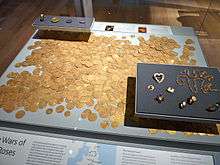 |
mid 15th century | Ravenshead Nottinghamshire 53°05′N 1°10′W / 53.08°N 1.17°W |
1966 | British Museum, London | 1,237 gold coins 8 pieces of jewellery 2 lengths of gold chain[47] |
| Fillongley Hoard | early 13th century | Fillongley Warwickshire 52°28′55″N 1°35′17″W / 52.482°N 1.588°W |
1997 | Warwickshire Museum, Warwick | 2 silver brooches silver finger ring 127 short-cross pennies[48] | |
| Gayton Hoard | late 12th century | Gayton Northamptonshire 52°10′12″N 0°59′35″W / 52.170°N 0.993°W |
1998–1999 | Ashmolean Museum, Oxford | 308 silver pennies 7 fragments[49] | |
| Glenluce Hoard | late 15th century | Glenluce sand-dunes Wigtownshire 54°51′00″N 4°52′59″W / 54.850°N 4.883°W |
1956 | 2 English silver coins 10 Scottish silver coins 99 Scottish billon coins 1 Scottish copper farthing[50] | ||
| Gorefield Hoard | early 14th century | Gorefield Cambridgeshire 52°40′59″N 0°05′31″E / 52.683°N 0.092°E |
1998 | British Museum, London Wisbech & Fenland Museum, Fitzwilliam Museum, Cambridge |
1,084 silver pennies, halfpennies and farthings[51] | |
| Llanddona Hoard | early 14th century | Llanddona Anglesey 53°17′38″N 4°08′20″W / 53.294°N 4.139°W |
1999, 2005–2006 | returned to finder | 970 silver pennies[52][53] | |
| Reigate Hoard | mid 15th century | Reigate Surrey 51°13′48″N 0°11′17″W / 51.230°N 0.188°W |
1990 | dispersed | 135 gold nobles, half nobles and quarters 6,566 silver groats[54] | |
| Rhoneston Hoard | late 15th century | Rhoneston, near Dumfries Dumfriesshire 55°09′14″N 3°42′29″W / 55.154°N 3.708°W |
1961 | 7 English silver coins 6 Scottish silver coins 70 Scottish billon coins[55] | ||
| Rumney Castle Hoard | late 13th century | Rumney Castle Cardiff 51°30′12″N 3°08′23″W / 51.50342°N 3.13970°W |
1981 | 63 silver pennies from the reign of Edward I[56] | ||
| Ryther Hoard | late 15th century | Ryther North Yorkshire 53°50′42″N 1°10′05″W / 53.845°N 1.168°W |
1992 | Yorkshire Museum, York | 812 silver coins, mostly English groats, half-groats and pennies dating from the reigns of Edward I/II through Henry VII, in an unglazed drinking jug.[57] | |
| Tutbury Hoard | early 14th century | Tutbury Staffordshire 52°51′N 1°41′W / 52.85°N 1.69°W |
1831 | dispersed | 360,000 silver coins (the largest hoard of coins ever discovered in Britain)[58][59] | |
| Twynholm Hoard | early 14th century | Twynholm Dumfries and Galloway 54°51′47″N 4°05′24″W / 54.863°N 4.090°W |
2013 | 322 silver coins dating from 1249 to 1325, including Scottish coins from the reigns of Alexander III and John Balliol, and English coins from the reigns of Edward I, Edward II and Edward III[60] | ||
| Wainfleet Hoard |  |
late 12th century | Wainfleet Lincolnshire 53°06′29″N 0°14′13″E / 53.108°N 0.237°E |
1990 | British Museum, London | 380 silver pennies and 3 halfpennies in a green-glazed ceramic bottle[61] |
Post-Medieval hoards
Most hoards from the post-medieval period, later than 1500, date to the period of the English Civil War (1642–1651), from which time over 200 hoards are known.[62]
| Hoard | Image | Date | Place of discovery | Year of discovery | Current Location | Contents |
|---|---|---|---|---|---|---|
| Abbotsham Hoard | mid 17th century | Abbotsham Devon 51°00′58″N 4°15′00″W / 51.016°N 4.250°W |
2001 | Bideford Museum | 9 gold coins 425 silver coins[63] | |
| Ackworth Hoard | mid 17th century | High Ackworth West Yorkshire 53°39′18″N 1°20′06″W / 53.655°N 1.335°W |
2011 | Pontefract Museum | 52 gold coins, 539 silver coins, and a gold ring inscribed "When this you see, remember me", in a clay Wrenthorpe ware pot.[64] | |
| Asthall Hoard | early 16th century | Asthall Oxfordshire 51°48′N 1°35′W / 51.80°N 1.58°W |
2007 | Ashmolean Museum, Oxford | 210 English gold angels and half-angel coins dating to the period 1470–1526[65] | |
| Bishops Waltham Hoard |  |
early 18th century | Bishops Waltham Hampshire 50°57′14″N 1°12′47″W / 50.954°N 1.213°W |
? | 7,083 forged French 30-denier coins dated 1711[66] | |
| Bitterley Hoard | 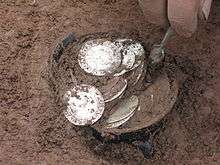 |
mid 17th century | Bitterley Shropshire 52°23′42″N 2°38′42″W / 52.395°N 2.645°W |
2011 | 1 gold coin and 137 silver coins (half crowns and shillings) with a leather purse in a tyg[67] | |
| Cheapside Hoard | late 16th to early 17th century | Cheapside, London | 1912 | Museum of London, British Museum, London, Victoria and Albert Museum, London | over 400 pieces of Elizabethan and Jacobean jewellery[68] | |
| Deal Hoard | mid 16th century | Deal Kent 51°13′23″N 1°24′04″E / 51.223°N 1.401°E |
2000 | British Museum, London | 191 base silver coins within a linen bag inside a pot[69] | |
| Hackney Hoard |  |
mid 20th century (1940) | Hackney London 51°34′16″N 0°04′52″W / 51.571°N 0.081°W |
2007 | British Museum, London | 80 American Double eagle gold coins minted between 1854 and 1913[70][71] |
| Haddiscoe Hoard | mid 17th century | Haddiscoe Norfolk 52°31′30″N 1°37′12″E / 52.525°N 1.620°E |
2003 | Elizabethan House Museum, Great Yarmouth | 316 silver coins[72][73] | |
| Hartford Hoard |  |
early 16th century | Hartford Cambridgeshire 52°20′13″N 0°09′32″W / 52.337°N 0.159°W |
1964 | British Museum, London | 1,108 silver groats from the reigns of Edward IV, Henry VI, Richard III and Henry VII, and double patards of Charles the Bold[74] |
| Lincoln Spanish-American gold hoards |  |
early 19th century | North Kesteven Lincolnshire 53°11′06″N 0°35′24″W / 53.185°N 0.59°W |
1928 2010 |
24 Spanish-American gold 8-escudo coins minted between 1790 and 1801 (18 discovered in 1928, and 6 discovered in 2010)[75] | |
| Mason Hoard[note 3] | 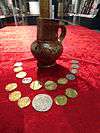 |
mid 16th century | Lindisfarne Northumberland 55°40′16″N 1°48′04″W / 55.671°N 1.801°W |
2003 | Great North Museum, Newcastle upon Tyne | 10 gold and 7 silver coins, including 11 English coins dating from the reigns of Henry VI through Elizabeth I and 6 coins from France, Saxony, the Netherlands and the Papal States, in a mid-16th century German jug.[76] |
| Middleham Hoard | |
mid 17th century | Middleham North Yorkshire 54°16′47″N 1°50′24″W / 54.2797°N 1.8399°W |
1993 | Dispersed amongst various museums and private collections, including Yorkshire Museum, York | 5,099 silver coins, comprising 4,772 English coins of Edward VI through Charles I, 31 Scottish coins, 10 Irish coins, 245 coins from the Spanish Netherlands, and 2 coins from the Spanish New World. The coins were found in three pots from two different pits, and were probably deposited at slightly different dates.[77] |
| Mitton Hoard | 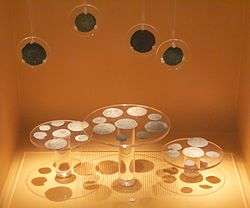 |
15th century | Great Mitton Lancashire 53°50′46″N 2°26′31″W / 53.846°N 2.442°W |
2009 | Clitheroe Castle Museum, Lancashire | 11 silver coins or fragments, including one or two from France.[78] |
| Nether Stowey Hoard |  |
mid 17th century | Nether Stowey Somerset 51°09′07″N 3°09′11″W / 51.152°N 3.153°W |
2008 | Somerset County Museum,Taunton | Silverware, including four spoons, a goblet and a bell salt, in an incomplete earthenware vessel[79] |
| Short Hoard[note 4] | mid 16th century | Lindisfarne Northumberland 55°40′16″N 1°48′04″W / 55.671°N 1.801°W |
1962 | 50 English silver sixpences and groats, the latest dating to 1562 during the reign of Elizabeth II, in a mid-16th century German jug.[76] | ||
| Tidenham Hoard | mid 17th century | Tidenham Gloucestershire 51°40′N 2°38′W / 51.66°N 2.64°W |
1999 | Chepstow Museum | 1 gold coin 117 silver coins[80] | |
| Totnes Hoard | mid 17th century | Totnes Devon 50°25′55″N 3°41′02″W / 50.432°N 3.684°W |
1930s | Totnes Museum | 176 silver coins of England, Scotland, Ireland and Spanish Netherlands[81] | |
| Tregwynt Hoard | mid 17th century | Tregwynt Pembrokeshire 51°58′12″N 5°04′23″W / 51.970°N 5.073°W |
1996 | National Museum Wales, Cardiff | 33 gold coins 467 silver coins a gold ring[62] | |
| Warmsworth Hoard | early 17th century | Warmsworth South Yorkshire 53°29′53″N 1°10′55″W / 53.498°N 1.182°W |
1999 | Doncaster Museum | 122 silver coins pottery fragments bronze alloy spoon[82] | |
See also
| Wikimedia Commons has media related to Hoards. |
Notes
- ↑ The hoard was uncovered when preparing a burial ground in an area called Harkirke, or Harkirk (meaning "hoary or grey church"), which is now park land. The only record of the coins was a copperplate engraving of thirty five of them which was reproduced in a book by John Spelman, published in 1678.
- ↑ The Ainsbrook Hoard is named after the two men who discovered the hoard, Mark Ainsley and Geoffrey Bambrook; it was covered in a special episode of the Channel 4 programme Time Team, first broadcast 14 January 2008. The programme was sceptical about the Viking origins of the hoard, and the location of the find was initially kept secret "to avoid the location becoming known to unscrupulous 'nighthawk' detectorists".[21]
- ↑ The Mason Hoard is named after its discover, Richard Mason, a builder who found the jug when working on an extension to a modern house in Lindisfarne; he did not realize the jug contained any coins until 2011. The Mason hoard was found at exactly the same location that the 1962 Short Hoard had been found at.
- ↑ The Short Hoard is named after its discover, Alan Short, a builder who found the jug when working on a modern house in Lindisfarne. The Mason Hoard was found at the same location in 2003.
Footnotes
- ↑ "Hoard from Ayton East Field". British Museum. Retrieved 7 August 2010.
- ↑ "The York Hoard: History of York". History of York. Yorkshire Museum. Retrieved 7 August 2010.
- ↑ Bland 2000, p. 129
- ↑ Bland 2000, p. 127
- ↑ Hitchcock 2006, pp. 184, 216
- ↑ Gannon, Voden-Decker & Bland 2004b, pp. 165, 184, 250
- ↑ Grierson, Philip (1979). "The Canterbury (St. Martin's) Hoard of Frankish and Anglo-Saxon Coin-Ornaments". Dark Age Numismatics: Selected Studies. London: Variorum Reprints. pp. 38–51, Corregida 5. ISBN 0-86078-041-4.
- ↑ "Selection from the Crondall hoard". Ashmolean Museum. Retrieved 14 July 2010.
- ↑ Historic England. "Monument No. 39092". PastScape. Retrieved 6 August 2010.
- ↑ Metcalf 1998, p. 109
- ↑ "Thousands of ancient coins discovered in Buckinghamshire field". BBC News. 2 January 2015. Retrieved 2 January 2015.
- ↑ "Six disc brooches from the Pentney hoard". British Museum. Retrieved 29 July 2010.
- ↑ "The largest hoard of Anglo-Saxon gold ever found: The artefacts in the hoard". Retrieved 14 July 2010.
- ↑ "penannular brooch". British Museum. Retrieved 25 July 2010.
- ↑ "Battle to keep Leeds treasure hoard". Yorkshire Evening Post. 26 October 2011. Retrieved 26 October 2011.
- ↑ "Roman and Pictish silver hoard uncovered by archaeologists". University of Aberdeen. 4 December 2014. Retrieved 5 December 2014.
- ↑ Graham-Campbell, James (1985). "A lost Pictish treasure (and two Viking-age gold arm-rings) from the Broch of Burgar, Orkney" (PDF). Proceedings of the Society of Antiquaries of Scotland. 115: 241–261.
- ↑ Stevenson, R. B. K.; Emery, John (1963–1964). "The Gaulcross hoard of Pictish silver" (PDF). Proceedings of the Society of Antiquaries of Scotland. 97: 206–211.
- ↑ Graham-Campbell, James (1991). "Norrie's Law, Fife: on the nature and dating of the silver hoard" (PDF). Proceedings of the Society of Antiquaries of Scotland. 121: 241–260.
- ↑ "St Ninian's Isle treasure". National Museums Scotland.
- 1 2 "Time Team Codename:Ainsbrook". Channel 4. Retrieved 12 August 2010.
- ↑ Hitchcock 2006, pp. 91–93, 215, 267–269
- ↑ Shetelig, Haakon (1940). Viking Antiquities in Great Britain and Ireland. 4. H. Aschehoug. pp. 51–53.
- ↑ "Hoard - YORYM-CEE620". Portable Antiquities Scheme. 26 September 2012. Retrieved 3 December 2012.
- ↑ "bibliographic record". British and Irish Archaeological Bibliography. Retrieved 17 October 2010.
- ↑ "Penny of King Cnut from the Bryn Maelgwyn hoard, Deganwy, c. AD 1020". Retrieved 6 August 2010.
- ↑ "The Cuerdale hoard". British Museum. Retrieved 14 July 2010.
- ↑ "Viking treasure haul unearthed in Scotland". BBC News. 12 October 2014. Retrieved 12 October 2014.
- ↑ "Viking coin hoard found in Furness, Cumbria". Portable Antiquities Scheme. 1 July 2011. Retrieved 1 July 2011.
- ↑ Prudames, David (3 August 2003). "Huge Hoard Of Viking-Age Silver Unearthed On The Isle Of Man". Culture24. Retrieved 18 July 2010.
- ↑ "Silver hoard from Goldsborough". British Museum. Retrieved 14 July 2010.
- ↑ Hitchcock 2006, pp. 62–63, 214, 252
- ↑ "Silver 'thistle' brooch". British Museum. Retrieved 14 July 2010.
- ↑ "Important Viking hoard highlights the continuing success of the Treasure Act and Portable Antiquities Scheme". Portable Antiquities Scheme. 14 December 2011. Retrieved 14 December 2011.
- ↑ "Skaill Hoard". National Museums Scotland. Retrieved 14 July 2010.
- ↑ "Vale of York hoard". British Museum. Retrieved 14 July 2010.
- ↑ Bland 2000, pp. 49–51, 128
- ↑ "Coins from Edward the Confessor and William the Conqueror found in Monmouth field". National Museum Wales. Retrieved 6 August 2010.
- ↑ "Ballaslig Coin Hoard". Manx National Heritage. Retrieved 18 July 2010.
- ↑ Reavill, Peter. "The FLO and the case of an extraordinary medieval coin hoard" (PDF). Retrieved 4 August 2010.
- ↑ Bland & Voden-Decker 2002, pp. 126–127, 134
- ↑ Gannon, Voden-Decker & Bland 2004a, pp. 140–141
- ↑ Bland & Voden-Decker 2002, p. 128
- 1 2 Brooks, Howard; Crummy, Nina; Archibald, Marion M. (2004). "A Medieval Lead Canister from Colchester High Street: Hoard Container, or Floor Safe?". Medieval Archaeology. 48: 131–142. doi:10.1179/007660904225022825.
- ↑ "Remarkable treasures unearthed by workman". National Museum Wales. Retrieved 6 August 2010.
- ↑ Bland & Voden-Decker 2002, pp. 128, 134
- ↑ "The Fishpool hoard". British Museum. Retrieved 14 July 2010.
- ↑ Bland 2000, p. 66
- ↑ Bland 2000, p. 130
- ↑ Jope, E.M.; Jope, H.M. (1959). "A hoard of 15th-century coins from Glenluce sand-dunes and their context" (PDF). Medieval Archaeology. 3: 259–279.
- ↑ Bland 2000, pp. 132–133
- ↑ Bland 2000, p. 134
- ↑ Barton & Hitchcock 2008, p. 230
- ↑ "The Reigate Hoard of silver coins and of international gold coins". Retrieved 4 October 2010.
- ↑ Stewart, B. H. I. H. (1961). "The Glenluce and Rhoneston Hoards of Fifteenth-Century Coins" (PDF). Proceedings of the Society of Antiquaries of Scotland. 93: 238–244.
- ↑ Youngs & Clark 1982, p. 225
- ↑ Barclay, Craig (1995). "The Ryther Treasure Trove" (PDF). British Numismatic Journal. 65: 135–150.
- ↑ "Historic hoard of coins goes on show at Tutbury Castle". Retrieved 14 July 2010.
- ↑ "Ruin and rebellion: uncovering the past at Tutbury Castle". Retrieved 16 July 2010.
- ↑ "Men unearth haul of mediaeval coins in Twynholm". The Scotsman. Retrieved 4 February 2014.
- ↑ "Mass, Prof. Jeffrey P (Short Cross), Part II". 16 March 2005. Retrieved 4 October 2010.
- 1 2 "The Tregwynt Hoard". British Museum. Retrieved 14 July 2010.
- ↑ Bland & Voden-Decker 2003, pp. 102–103, 106
- ↑ "The Ackworth Hoard". Wakefield Council. Retrieved 15 November 2012.
- ↑ "Tudor Golden Angels head to Oxford as Ashmolean Museum secures the Asthall Hoard". Culture24. 6 December 2010. Retrieved 7 December 2010.
- ↑ "Record ID: HAMP-E4E185". Portable Antiquities Scheme. 8 June 2010. Retrieved 19 July 2012.
- ↑ "Inquest into the discovery of a 17th Century Coin Hoard from Bitterley, South Shropshire". Portable Antiquities Scheme. 28 June 2012. Retrieved 28 June 2012.
- ↑ The Cheapside hoard, Museum of London image
- ↑ Bland & Voden-Decker 2002, pp. 129–130, 134
- ↑ "Hoard of American gold Double-Eagles dug up in Hackney". Portable Antiquities Scheme. 18 October 2010. Retrieved 18 October 2010.
- ↑ "The Hackney Hoard". British Museum. 18 April 2011. Retrieved 18 April 2011.
- ↑ "The Haddiscoe Hoard". Norfolk Museums and Archaeology Service. Retrieved 16 July 2010.
- ↑ Gannon, Voden-Decker & Bland 2004b, pp. 167–168, 184
- ↑ "All Saints Church Hartford — History". Retrieved 4 October 2010.
- ↑ "Spanish-American Gold Coin Hoard declared Treasure". Portable Antiquities Scheme. 23 November 2010. Retrieved 23 November 2010.
- 1 2 Ochota, Mary-Ann (2013). Britain's Secret Treasures. Headline. ISBN 978-0-7553-6573-9.
- ↑ Barclay, Craig (1994). "A Civil War Hoard from Middleham, North Yorkshire" (PDF). British Numismatic Journal. 64: 84–98.
- ↑ Coin hoard BM-193206, Finds.org.uk, Retrieved 16 September 2015
- ↑ "British Museum to Manage Portable Antiquities Scheme...". Art Daily. 24 November 2010. Retrieved 8 December 2010.
- ↑ Bland 2000, pp. 140–141
- ↑ Bland 2000, pp. 141–142
- ↑ Bland 2000, p. 140
References
- Barton, Caroline; Hitchcock, Fi, eds. (2008). Treasure Annual Report 2005/6 (PDF). Department for Culture, Media and Sport.
- Bland, Roger, ed. (2000). Treasure Annual Report 1998 - 1999 (PDF). Department for Culture, Media and Sport.
- Bland, Roger; Voden-Decker, Lisa, eds. (2002). Treasure Annual Report 2000 (PDF). Department for Culture, Media and Sport.
- Bland, Roger; Voden-Decker, Lisa, eds. (2003). Treasure Annual Report 2001 (PDF). Department for Culture, Media and Sport.
- Gannon, Anna; Voden-Decker, Lisa; Bland, Roger, eds. (2004a). Treasure Annual Report 2002 (PDF). Department for Culture, Media and Sport.
- Gannon, Anna; Voden-Decker, Lisa; Bland, Roger, eds. (2004b). Treasure Annual Report 2003 (PDF). Department for Culture, Media and Sport.
- Hitchcock, Fi, ed. (2006). Treasure Annual Report 2004 (PDF). Department for Culture, Media and Sport.
- Lewis, Michael, ed. (2009). Portable Antiquities and Treasure Annual Report 2007 (PDF). Department of Portable Antiquities and Treasure, British Museum. ISBN 978-0-9563795-1-1.
- Metcalf, David Michael (1998). An atlas of Anglo-Saxon and Norman coin finds, c.973-1086. Royal Numismatic Society. ISBN 978-1-85444-110-2.
- Youngs, Susan B; Clark, John (1982). "Medieval Britain in 1981" (PDF). Medieval Archaeology. 26: 164–227. doi:10.5284/1000320.
